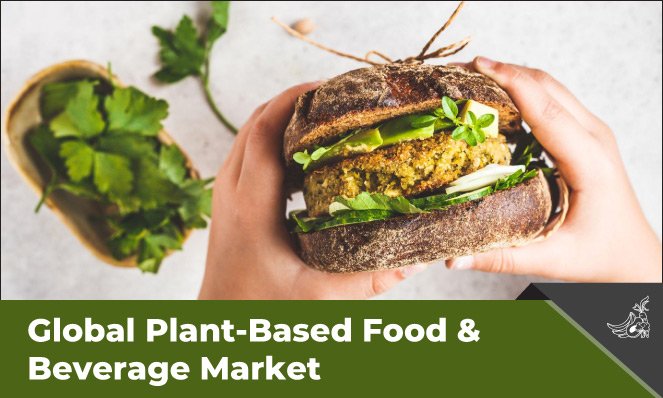
A 2022 study on Sweden’s attitude toward plant-based foods involved four groups, flexitarians, consumers who prefer to only eat meat, consumers who prefer meat & fish but avoid vegetarian food, and omnivores (mixed diet). The study found that flexitarians consume considerably more Plant-Based Meat Alternatives (PBMA) and pulses than the other three groups. Additionally, it concluded that flexitarians’ beliefs and attitudes aligned with sustainability (Source). As per Inkwood Research, the global plant-based food & beverage market is estimated to register a CAGR of 10.79% and reach a revenue of $104707.43 million by 2032.
This blog attempts to explain how flexitarians can be a lucrative target group for plant-based food & beverage companies.
Flexitarianism is going mainstream. It is comparatively less strict than veganism and vegetarianism since it does not entirely eliminate meat or dairy products from the daily diet. At the same time, it promotes incorporating a significant amount of fruits, vegetables, plant-based proteins, and whole grains.
Flexitarian Proteins – Best of Both Worlds
The global demand for protein is rising with the growing population and income levels. As a result, there will be increased demand for plant and animal proteins. Moreover, as per a May 2021 USB Soy Protein and Flexitarian Study, young consumers drive plant-based protein demands. The respondents self-identified as vegan, flexitarian, pescatarian, omnivore, and vegetarian. As per the study, 65% of consumers in the United States welcome plant-based foods. However, the interest is highest among the younger generation. Further, as per the same study, 60% of consumers aged 60 and below agree that a plant-based protein is complete.
At the same time, limited intake of animal products or meat warrants insufficient protein intake concerns. In this regard, flexitarians have ample choices regarding protein sources. They often eat plant-based and conventional dairy products like soy milk and animal-based milk, which are considered complete protein sources.
Concerning soy protein, says Kennan McRobers, Ph.D., vice president of science and program strategy for United Soybean Board, “Soy protein provides the highest percentage of protein per calorie compared to other plant protein sources. The high protein density of soy protein readily contributes to meeting requirements for protein and the amino acids that make up protein. In addition, the soybean oil (fat) component in soybeans contributes to meeting essential fatty acid requirements.” (Source)
As per our evaluation, soy is projected to garner a revenue of $41893.44 million by 2032 under the source segment.
Which Factors Govern Flexitarian Choices?
According to studies conducted by BayWa, several factors drive flexitarians to experiment with new food categories in the plant-based market. One is sustainability. They do not want a remorseful bite of a burger and want to eat to their heart’s content of benevolence. Benevolence at having contributed to the creation of a healthy world.
Furthermore, as per research by BENEO, flexitarians are particularly interested in food adventures, sustainability, and transparent labels. 84% were concerned about climate change, whereas 86% wanted to know about the food manufacturing process. The company thus states that understanding the expectations and desires of flexitarians is vital to plant-based product development. In addition, half of the respondents were inclined to keep up with the latest food trends. This enables opportunities for adventurous food production. However, texture and pleasant taste remain pivotal to repeated purchases for flexitarians.
Explains Myriam Snaet, Head of Market Intelligence and Consumer Insights, BENEO, “Flexitarians are the driving force within the plant-based segment and they are a sophisticated target group: they are looking for a convenient way to include innovative and adventurous taste experiences in their daily diet and aren’t willing to compromise on enjoyment. Delivering on taste and texture is key to building a loyal consumer base. Thanks to ingredients such as those from Beneo it is possible for ‘plant-based’ and ‘indulgence’ to go hand in hand for a wide variety of applications.” (Source)
Will Flexitarianism Take Over?
The world waking up to zero meat consumption is incomprehensible. Flexitarians, for instance, have not categorically ruled out any type of food, plant-based or animal-based. Even so, two primary obstacles stand guard against zero meat consumption – price and taste. These obstacles are pivotal. Compared to their animal-based counterparts, plant-based foods are 50%-100% costlier. Given the expense and the size of the units, these attract only elite circles of consumers while inadvertently turning away price-sensitive potential buyers.
Accordingly, general and plant-based food retailers and producers still need to find new ways to win over the non-consumers. Besides, non-consumers will need more fervent reasons than environment and ethics to shell out for plant-based foods and beverages. The taste has to be consistent and comparable with animal-based products without costing three times as much. Higher sales volumes and new production technologies might facilitate achieving this goal.
Says Frank Giezen, co-founder of Ojah, “We push our private-label customers not to charge too high on the main market. This indirectly puts pressure on the brands to lower their prices too.” (Source)
What can Brands do for Flexitarians?
Flexitarians are increasingly scrutinizing the manufacturing processes and ingredients of the products on grocery shelves. Therefore, marketing will play an indispensable role in consumer acceptance. Besides, brands can be mindful of the trends influencing flexitarians’ purchasing decisions and develop appropriate strategies.
Some of the trends evaluated to influence the buying decision of flexitarians include:
- Good Taste and High Protein Content
- Price Parity with Conventional Animal-Based Products
- Comfort and Convenience
- Regional Production
- Sustainable Packaging
Considering the aforementioned aspects, flexitarians can be a lucrative target group for the global plant-based food & beverage market players.
By Akhil Nair
FAQs:
Which is the largest revenue-generating region in the global plant-based food & beverage market?
Europe is the largest revenue-generating region in the global plant-based food & beverage market.
Which country projects promising growth avenues for plant-based foods and beverages?
South Korea projects promising growth avenues for plant-based foods and beverages.
